Ripley's Strangest Animals
Edward Meyer, Ripley's Believe It Or Not, Download The Weird
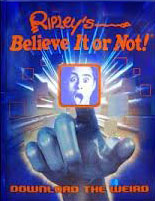 For over 30 years Edward Meyer traveled around the world collecting unusual stories and unbelievable artifacts to fill Believe It or Not! books and museums. He acquired over 20,000 different museum artifacts, everything from a pin valued at $1 million dollars, to a two-trunked elephant, to Marilyn Monroe's lingerie, to Lee Harvey Oswald's mortuary toe tag, to a meteorite from Mars. The list is endless.
For over 30 years Edward Meyer traveled around the world collecting unusual stories and unbelievable artifacts to fill Believe It or Not! books and museums. He acquired over 20,000 different museum artifacts, everything from a pin valued at $1 million dollars, to a two-trunked elephant, to Marilyn Monroe's lingerie, to Lee Harvey Oswald's mortuary toe tag, to a meteorite from Mars. The list is endless.
The Ripley's book, Download The Weird, includes a little bit of technology. Just like the title implies, there is a Ripley phone app you can download for free. Once you have the app, there are 17 pages in the book that you can take a picture of with your iPhone. Just look for the red and green logo throughout the book, which states "OddScan." Once you do this, you will be exposed to more information, more photos, maybe an interview or a video.
We talked with Edward about some of the astonishing dog stories and crazy cat stories in this edition of Ripley's, which contains 256 pages with about 2,500 stories including about 500 photographs. One of the sections in the book includes a whole chapter on animals, of about 25 pages.
One of the stories you will find are the Shaggy Dog Story about Norman, a shaggy Briard dog owned by the Cobb family of Canton, Georgia, who has been riding a scooter since he was a puppy. He balances on the scooter unaided with his front paws resting over the handlebars while he pushes himself along using his hind leg. Videos of his tricks have been a massive hit on YouTube, and he even has his own Facebook page.
A second dog story was about dog owners in New Taipei City, Taiwan, who were given the chance to turn their pet' poop into gold. In an attempt to clean up the streets, anyone handing in a bad of dog poop was entered in a lucky draw, the top prize for which was $2,100 in gold bars. Animal Radio Host Hal Abrams thinks we should try this here in the United States!
 Another dog story was about a $1.5 million dollar puppy. A red Tibetan mastiff puppy named Hong Dong was sold for $1.5 million in 2011. Tibetan mastiffs are fierce guard dogs and are rarely found outside Tibet, which makes them highly exclusive and sough-after. Hong Dong was bred in Qingdao, China, and weighed more than 180 lb. (82kg) at 11 months.
Another dog story was about a $1.5 million dollar puppy. A red Tibetan mastiff puppy named Hong Dong was sold for $1.5 million in 2011. Tibetan mastiffs are fierce guard dogs and are rarely found outside Tibet, which makes them highly exclusive and sough-after. Hong Dong was bred in Qingdao, China, and weighed more than 180 lb. (82kg) at 11 months.
With regard to the cat stories, we talked about Frank and Louie, a two-faced cat. Despite being born with two faces, two mouths, two noses, and three eyes, Frank and Louie, a cat owned by Marty Stevens of Worcester, Massachusetts, set a world record by living to the age of 12. Most Janus cats, named after a Roman god with two faces, fail to survive, often because their two mouths cause them to choke. However, although both of Frank and Louie's noses worked, only one mouth did. The nonfunctioning mouth wasn’t connected to his sole esophagus, meaning that he couldn’t eat with it. Frank and Louie had a single brain, meaning both faces reacted simultaneously.
Edward Meyer's favorite picture in the book is about Ksyusha, a white-haired Himalayan kitten who can somehow squeeze herself into a small glass jar. Her owner, Yuriy Korotun of Moscow, Russian, said the kitten (nicknamed "Mewdini") loves to curl up in confined spaces but always manages to escape unharmed. Edward's own cats do pretty strange things and like to sleep in strange places, but nothing like this kitty!
No matter what strange or odd things you are into, you will surely find something fascinating in this latest Ripley's book.
Visit Website
Pet Pictures Boost Productivity
Sarah Cliff, The Washington Post
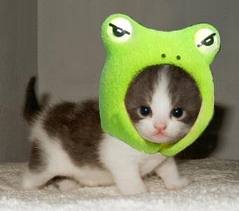 According to a Japanese study done at Hiroshima University, viewing photos of cute animals at work boosts productivity.
According to a Japanese study done at Hiroshima University, viewing photos of cute animals at work boosts productivity.
To test their hypothesis, the researchers separated 48 volunteer students into two groups, and asked them to play game similar to Milton Bradley's "Operation." After the first session of the game, students from the first group were shown various photos of cute baby animals, while the second was shown photos of adult animals. The first group fared better.
In a second test, the researchers split the volunteers into three groups. This time they were tasked with remembering and stating the number of times a given number appeared in a sequence. Again, a group was shown photos of baby animals, another photos of adult animals, and the other was shown photos of "pleasant foods," including sushi and steak. Apparently the volunteers who were entertained with photos of cute baby animals significantly outperformed participants from the other two study groups.
In a third and final test, 36 right-handed university students who did not participate in the previous experiments were selected. Again, these were divided into three groups, each stimulated by photos of baby animals, adult animals and neutral (food), respectively, and asked to perform a reaction time (RT) task. Participants were asked to indicate whether a stimulus presented on a cathode ray tube screen contained the letter H or the letter T by pressing the left or right key on a response pad as quickly and as accurately as possible. Curiously, here the cute animal-viewing group scored the lowest. The researchers write, "The narrowed attention may be beneficial to performance on tasks that require carefulness in the motor and perceptual domains, such as the tasks used in the first two experiments."
Sara told us that there is an evolutionary explanation to these results. When we see a baby animal that has those big eyes, it looks helpless. You then become a little more aware of this vulnerable creature that you are looking at and you become a little more careful with how you're moving.
So if you have cute pictures of baby animas on your computer, tell your co-workers there is a good reason and to leave you alone!
The Dangers of Doggie Dragon Breath - Dr. Debbie
 Does your dog's breath cause you to gag and turn away? Are your pet's kisses unwelcome due to fetid breath? Many dog owners recognize that distinctive smell which is often accepted as a condition of dog ownership. But stinky dog breath, while common, is actually a symptom of illness and should not be ignored. Doggie dragon breath, just like a blinking traffic light, is a sign of danger ahead. Don't ignore dog breath for what it is - an indicator of oral infection that if left unchecked will impact your dog's health and shorten his lifespan.
Does your dog's breath cause you to gag and turn away? Are your pet's kisses unwelcome due to fetid breath? Many dog owners recognize that distinctive smell which is often accepted as a condition of dog ownership. But stinky dog breath, while common, is actually a symptom of illness and should not be ignored. Doggie dragon breath, just like a blinking traffic light, is a sign of danger ahead. Don't ignore dog breath for what it is - an indicator of oral infection that if left unchecked will impact your dog's health and shorten his lifespan.
What's the big deal about bad breath? It's more than just the smell. Bad breath, also referred to as halitosis, arises from plaque and oral bacteria. Periodontal disease progresses as plaque accumulates, mineralizes into tartar, and inflammation causes destruction of the supportive tissues around the teeth. Dogs don't simply get cavities, rather they will lose their teeth as connective attachments deteriorate. Untreated dental infections jeopardize the health of nearby teeth and may lead to osteomyelitis - infection in the bone. And with time, untreated periodontal disease showers the bloodstream with bacterial products leading to other diseases such as liver, kidney and heart disease.
Fight Halitosis
The best way to control periodontal disease is to assume an offensive attack. Monitor your pet's oral health by flipping up your dog's lip to discover what is lurking underneath. Look for red inflamed gums, yellow or brown accumulation on the teeth, tooth discoloration, or bad breath. Any symptoms of periodontal disease should be addressed with your veterinarian. Have your pet's teeth cleaned regularly at the veterinary office and follow up with home dental care including daily brushing.
These professional veterinary cleanings are important to safely remove mineralized tartar, clean under the gum line, permit a thorough oral exam and take x-rays. Veterinary dental x-rays are an essential tool in detecting problems and have been shown to identify oral disease in 28-percent of dogs and 42-percent of cats that have an outwardly normal mouth.
Don't fall into the hype about herbal spray-on products or 'awake' dental procedures - these only offer a cosmetic improvement in visible tartar, which only covers a small part of the tooth. These methods, often incorrectly touted as a safe alternative to professional cleanings, can't address the 60-percent of a dog's tooth which lies under the gum line - exactly where periodontal disease brews and does its damage.
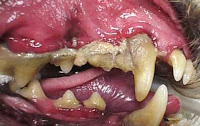 Once you identify that nasty doggie breath, you can be certain some degree of periodontal disease is present and dental intervention is needed. Statistics show that by 3 years of age 80-percent of dogs and cats already have periodontal disease. Don't forget that small and toy breeds of dog have accelerated dental problems diagnosed as young as 1 to 2 years of age.
Once you identify that nasty doggie breath, you can be certain some degree of periodontal disease is present and dental intervention is needed. Statistics show that by 3 years of age 80-percent of dogs and cats already have periodontal disease. Don't forget that small and toy breeds of dog have accelerated dental problems diagnosed as young as 1 to 2 years of age.
Think prevention - have your dog's teeth cleaned and embrace home dental care steps. And the next time you find yourself in a cloud of canine halitosis, you won't turn the other way - you'll grab that toothbrush.
Featured veterinarian known as "Dr. Debbie" on national pet radio program, Animal Radio. Ebook author of "Yorkshire Terriers: How to Be Your Dog's Best Friend"; "Pugs: How to Be Your Dog's Best Friend"; "Mini Schnauzers: How to Be Your Dog's Best Friend"; and "Shih Tzu: How to Be Your Dog's Best Friend." Dr. Debbie's books.
Visit Website
The Dogfather's Grooming Tip with Joey Villani
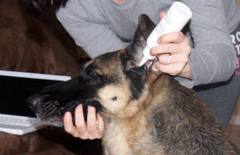 General Ear Cleanser
General Ear Cleanser
Maybe it's the time of year, but Joey seems to be getting a lot of requests for a good ear cleaner.
When looking for a good general ear cleanser, there are a couple of variations you need to take under consideration. Are you using it just for general cleaning? Are you trying to clean something up like an infection or ear mites? You first need to determine the reason for cleaning your pets' ears.
If you are not sure if your pet has an ear infection, just smell their ears. Their ears actually should not have a smell to it (other than just smelling like a dog!). So if you smell any type of odor that smells yeasty or sour, or if there is any discharge, take your dog to a veterinarian and have their ears cleaned professionally.
Some dogs, like Cocker Spaniels and Setters, have reoccurring ear infections due to the fact that they long, thick ear flaps that prevents air from getting into their ears and drying them out. These types of dogs usually have moist ears, which encourages bacteria to grow.
If you don't detect any odd odors, and your dog has an abundance of hair in his ears, you want to remove it. You might not want to do this at home, because you don't cut the hair out, you need to pull it out.
Okay, so now there is no hair and there is no odor. You can make a good ear cleanser at home with witch hazel or white vinegar. If you are using vinegar, mix it with half vinegar and half with distilled water. Distilled water is safer than tap water, because you know that there is nothing in it. Then, take a cotton ball and dip it in the solution and swab it out. Just go down into the ear as far as you can see. You don't want to go too deep. When you are done, throw the remaining solution out. Do not store it, as it can go bad.
If you are going to do an actual ear flush, make sure you get the proper solution from your veterinarian.
If your dog has normal ears, all you need to do is clean them one to two times per month.
Animal Radio News with Stacey Cohen
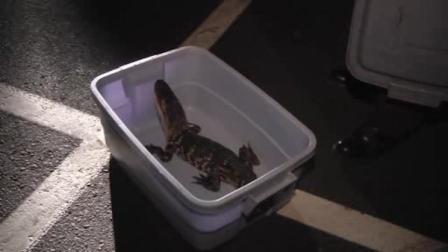 Alligators On The Loose In Long Island
Alligators On The Loose In Long Island
An alligator was found in a supermarket parking lot on New York's Long Island, just a day after another gator was discovered in the same lot. A 3-to-4-foot-long alligator was discovered in a parking lot, after a 2-to-3-foot gator was found there the previous day. The reptiles were captured and turned over to the Nassau County Emergency Services Unit. They were sent to a reptile sanctuary in Florida. The authorities believe that someone dumped them there. It was the third gator sighting on Long Island in less than a week. Previously, an alligator was found crawling on the front lawn of a Mastic beach home.
Man Dies After Roach Eating Contest
Broward County authorities say the winner of a roach-eating contest died shortly after eating dozens of roaches and worms. Several contestants ate insects to win a python. The Broward Sheriff's Office says the winner of the challenge became ill soon after and collapsed in front of the store. He was taken to the hospital, where he was pronounced dead. No other contestants became sick after the contest.
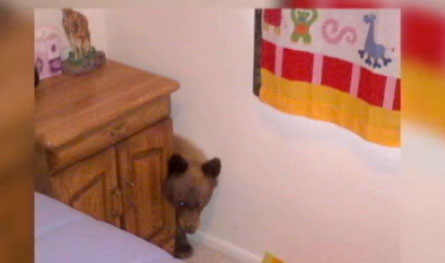 Bear Breaks Into Home For Cake
Bear Breaks Into Home For Cake
A hungry, orphaned black bear cub that entered an Arizona home, eating chocolate cake before being discovered by the awakened homeowners, was sent to a local zoo. Arizona Game and Fish Department officers responded to a call of a black bear inside a home in the Sonoita area. "Homeowners awoke to find a bear cub had entered their home through an open kitchen window and eaten some chocolate cake," the agency stated. "Since there was no sign of an adult bear in the area, Game and Fish removed the cub and transferred the orphaned bear to the Heritage Park Zoo in Prescott." Since the cub was too young to fend for itself in the wild, it was expected to become part of a future zoo exhibit. Remember, bears have an incredibly keen sense of smell even from long distances and human food is very attractive to them! Arizona has an estimated 2,500 black bears, the only bear species found in the state.
 Otter Artists
Otter Artists
A pair of otters made it clear that their art wassn't worthless after their paintings became a hit in their Minnesota aquarium's gift shop. Zhoosh and Anang first started painting by smearing blobs of children's paint on pieces of card stock. Each painting takes about 15 minutes to complete and the best ones are framed and put up for sale in the gift shop.
Eight Lives Left
One life down and eight more to go for a kitten that was rescued from a car's engine in Maryland. Firefighters responded when a BMW owner who had just left an auto repair shop heard what sounded like a cat meowing from inside his car. A firefighter reached into the engine compartment and pulled out a brown and white kitten small enough to fit on his hand. The itty-bitty kitty probably crawled inside the car at the repair shop. It was a bit frightened, but was said to be just fine otherwise.
Pot-Bellied Pig Terrorized Neighborhood
A freewheeling miniature pot-bellied pig was wreaking havoc on a Pennsylvania neighborhood. The animal, which some had taken to calling "Dozer,” had been rooting around and destroying people's yards in Midland Heights. The Pennsylvania Game Commission suspects "Dozer" used to be someone's pet, but was left behind when that person moved away.
 Listen to the entire Podcast of this show (#1189)
Listen to the entire Podcast of this show (#1189)





